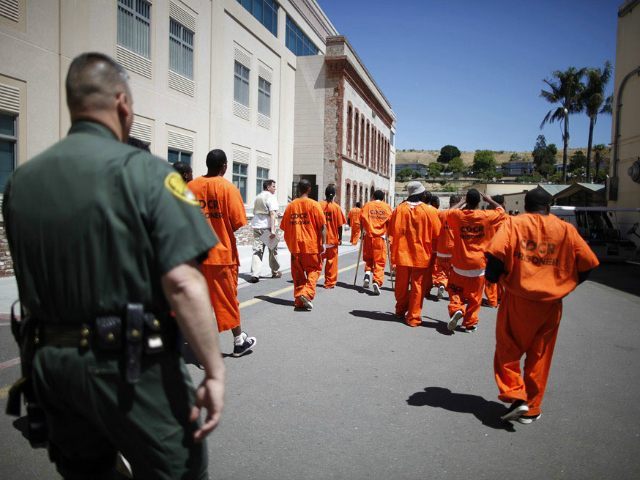It’s because the criminals are in jail, dummies.
One of the oddest spectacles of recent years has been the political class’s utter befuddlement as to the decline in crime over recent decades. Crime has declined in spite of an increase in guns (or because of it); in spite of bad economics (or because of it); in spite of government spending (or because of it). It never seems to occur to these geniuses that the reason crime has declined is because we threw more criminals in jail.
And so, naturally, our politicians now want us to release more bad guys.
On Wednesday, Sen. Chuck Grassley (R-IA), Sen. John Cornyn (R-TX), Sen. Dick Durbin (D-IL0, Sen. Sheldon Whitehouse (D-RI), Sen. Mike Lee (R-UT0, Sen. Lindsey Graham (R-SC), Sen. Chuck Schumer (D-NY), and Sen. Cory Booker (D-NJ) put together a bill that would lower criminal penalties for “non-violent drug offenders.” The purpose is not lowering crime. It’s “making the criminal justice system fairer, particularly for African Americans, following the Baltimore and Ferguson riots,” according to Politico.
You read that correctly: In the aftermath of people rioting, looting, and committing acts of vandalism and violence, Congress’s solution is to let more criminals out of prison.
The bill itself—the Criminal Justice Reform and Corrections Act of 2015—would “reduce overcrowding” and “cut recidivism rates by letting low-risk prisoners earn reduced sentences and improving programs that prepare inmates for life after prison.” Also, these aspiring do-gooders will be sprinkled with fairy dust.
The notion of releasing low-risk offenders sounds grand—after all, they’re low-risk! But the government has a poor track record when it comes to preventing recidivism. According to the Bureau of Justice Statistics, “An estimated two-thirds (68 percent) of 405,000 prisoners released in 30 states in 2005 were arrested for a new crime within three years of release from prison, and three-quarters (77 percent) were arrested within five years, the Bureau of Justice Statistics (BJS) announced today.”
But what about “non-violent” offenders—precisely the sort of offenders we’re supposed to let off the hook? It turns out they go back to crime significantly more than violent offenders:
Prisoners released after serving time for a property offense were the most likely to recidivate. Within five years of release, 82 percent of property offenders were arrested for a new crime, compared to 77 percent of drug offenders, 74 percent of public order offenders and 71 percent of violent offenders.
Here’s the reality: crime is down because incarceration of risky criminals is up. And when we release risky criminals, crime rises. Arguing in favor of lower sentences for certain crimes on principle is one thing. Arguing that such policies reduce crime, however, is nonsense.
Without evidence, we hear the argument that drug offenders make up the bulk of the poor saps in prison. That’s baloney. As David Brooks points out at the New York Times, few people are behind bars for drug offenses—just 17 percent of those in state prisons are there for drugs. That percentage has been declining steadily for years. In fact, as Brooks states, we’re not even keeping prisoners jailed for longer; we’re just prosecuting more people for felonies.
So yes, mass incarceration seems to work.
Now, government routinely reclassifies crimes so as to avoid the inescapable conclusion that letting risky offenders out of jail poses a risk to the public—that’s why California, for example, fudges its statistics routinely. But it’s clear that putting risky criminals in jail for long periods of time benefits society. Columnist Inimai Chettiar of The Atlantic wrote in February:
[O]ver the past 25 years, the tide of crime and violence seemed to simply recede. Crime is about half of what it was at its peak in 1991… Since 1990, incarceration nearly doubled, adding 1.1 million people behind bars. Today, our nation has 5 percent of the world’s population and 25 percent of the world’s prison population. The United States is the world’s most prodigious incarcerator.
The problem, as Chettiar explains, is that we may have reached the saturation point in terms of incarceration. But that’s a testament to the success of incarceration efforts, not a point against it. The argument that we have imprisoned so many bad criminals that there are only marginal criminals left—and that imprisoning those criminals doesn’t accomplish much—does not suggest that we should let the dangerous criminals out of prison.
Evidence that over-the-top imprisonment isn’t wildly effective is not evidence that under-enforcement will be more effective. And yet that is precisely what many on both sides of the aisle seem to think. They suggest that releasing desperate, drug-selling Jean Valjeans from prison will have no negative impact; they’ll become mayors and help lift carts off of passersbys.
Or, perhaps, the crime rate will rise as we continue to avoid the obvious lessons of successful policy. If we’re going to start releasing criminals, perhaps we ought to be careful about it, rather than doing so in a wild fit of gusto over the supposed horror and injustice of treating criminals like criminals.
Ben Shapiro is Senior Editor-At-Large of Breitbart News, Editor-in-Chief of DailyWire.com, and the New York Times bestselling author, most recently, of the book, The People vs. Barack Obama: The Criminal Case Against The Obama Administration (Threshold Editions, June 10, 2014). Follow Ben Shapiro on Twitter @benshapiro.

COMMENTS
Please let us know if you're having issues with commenting.